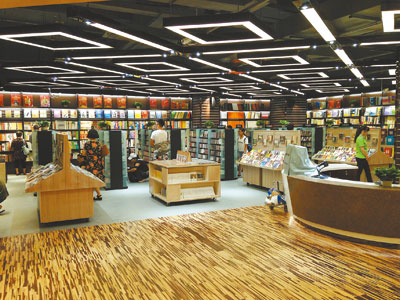
Zhang Xiaoyi
417880236@qq.com
MORE than 100 people crowded into the marble-floored lobby of Luohu Book City for the 20-year-old store’s reopening ceremony at 10 a.m. July 16. At one end of the lobby, plastic boards were arranged in a small circle to display the historical development of the Book City bookstore.
“Why are we throwing this ceremony? Because Luohu Book City was the first bookstore to embody the idea of a ‘book city’ in China,” said Hu Zhongjian, vice manager of the culture and resource center at Luohu Book City.
Book city is now a national brand that was, according to Hu, first dreamed up in the 1990s. It challenged the common idea of what a bookstore was, mirroring the former’s huge collection and diverse categories of books. This market positioning and business model set the trend after its first store was launched in Shenzhen’s Luohu District on Nov. 8, 1996. Other Book City outlets such as the ones in Nanshan and Futian CBD were built in 2004 and 2006, respectively.
After years of glory, book city is now facing challenges spurred by the Internet, especially the emergence of online bookstores and the popularity of e-books. To cope, Luohu Book City strived to solidify its place in Shenzheners’ lives through a renovation of its interior space and the creation of a unique reading experience.
New interior, old facade
“The renovation first started on the fourth floor and then finished on the second floor,” said a staffer at Luohu Book City. The work began in February this year and lasted for four months.
The result was that by stepping inside one of the oldest buildings in Shenzhen, one would feel brightened up by its finely crafted and modern design. It is in stark contrast to the outdated facade, where four large golden Chinese characters “Luo Hu Book City” are attached — a collage of past and present.
After renovations, tiles were replaced by wooden flooring and steel bookshelves replaced wooden ones. The ceilings underwent huge transformations, which are now decorated with stylish lights. Displays of books are carefully attended to with a sense of aestheticism.
Apart from an upgraded design, the interior space was economically divided into sections that serve various functions. A music section with walls of CDs is modernly designed and seated at a quiet corner of the second floor. A cozy book bar is adjacent to an array of books on the third floor, breaking the rigid layout the place used to have. The classic books area harbors rows of ancient literature that suit those who have a taste for ancient linguistic styles. The lecture section, where gray chairs are lined up in rows, adds to the already strong cultural aura the place creates. The Children’s Experience Corner balances the seriousness with innocent giggles.
“We wanted to create a multi-functional place, where people can not only read but also meet their friends. That’s why we introduced lots of humane designs to serve our customers,” said Sun Taiqing, manager of Luohu Book City.
The new space aims to create a unique reading experience any e-commerce store could not provide.
“We have indeed been impacted by the e-book market. However, what we provide is a real place, where readers can stroll among the books and freely look at any of the books we have on our shelves. This helps trigger their impromptu needs. It’s an experience we provide,” said Sun.
The new store resonates with the concept of an “experience economy,” which means, “Businesses must create memorable events and experiences that capture their audience and create experiences that transform their brand’s value proposition.” Distinct from the Internet economy, the idea guided this historic landmark to reposition itself to regain the spotlight of the cultural field.
Though underlined by different ideas, Luohu Book City embraces Internet technology to enhance its services.
“We recommend books and take book orders on our official Wechat account. There are different combinations of books recommended, targeting different segments of readers based on the data we procure,” said Sun.
Memories of the 1990s
According to Sun, the regulars of Luohu Book City are bookworms who have been long in love with the place. The bookworms, young and old, grew up with the city, and Luohu Book City, which industrially promoted a reading culture citywide back in the 90s. As a result, the place has a special bond with 1990s Shenzhen and the second generation of Shenzheners.
“Every time I went to Luohu Book City, I had to buy ice cream at Diwang Mansion across the street,” a reader surnamed Gao, a second-generation Shenzhener who is studying for her master’s degree in Hong Kong, recalled.
A reader surnamed Lin, a graduate of Jilin University who is also a second-generation Shenzhener, said, “I remember the lobby and the chandelier hanging from its ceiling. From 1996 to 1999, when I was in primary school, I usually spent my weekends here because back then there was nowhere else to go.”
She continued, “There were always many more books here than at the library. I would read in the kid’s section and then slip to the top floor, looking at the stamps, ancient coins and stuff on display. I was so curious and happily found that there was much to see. And that’s when I truly found the pleasure of reading.”
“My mom used to have lots of book coupons, which allowed me to go to Book City and buy dozens of books. I also remember diving into the music section, trying to find an album I wanted by flipping through every record. Later when e-commerce became popular, I stopped going to Book City,” said a reader surnamed Huang, who earned a degree in public relations in England. “But I can’t deny that I still love the sense of touching a paper book or a physical CD,” she said.
|

